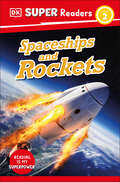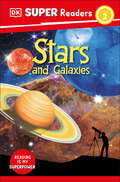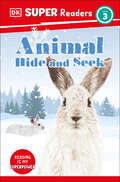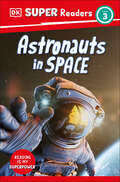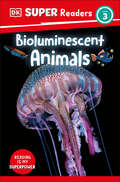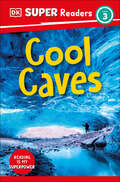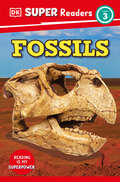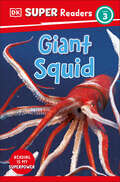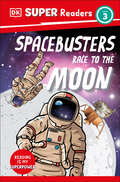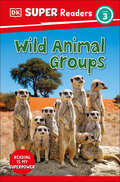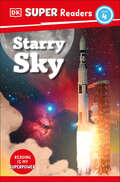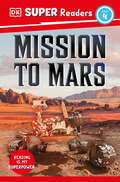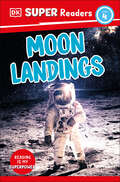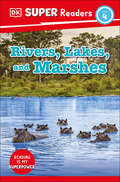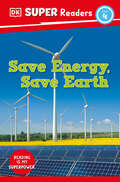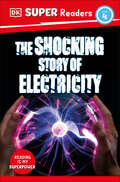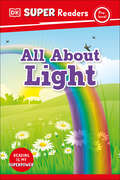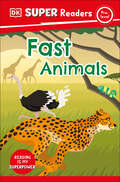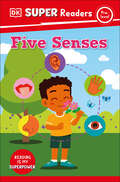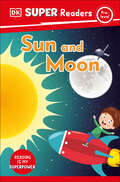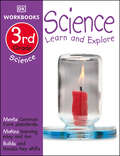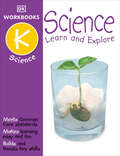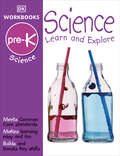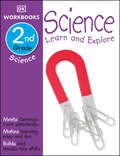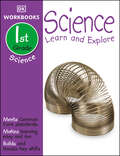- Table View
- List View
DK Super Readers Level 2 Spaceships and Rockets (DK Super Readers)
by DKHelp your child power up their reading skills and learn all about travel in space with this fun-filled nonfiction reader carefully leveled to help children progress.DK Super Readers Level 2: Spaceships and Rockets will assist kids in their learning about early space missions and the future of space exploration—including fun facts about the parts of a rocket and today&’s space stations and probes—and is a motivating introduction to using essential nonfiction reading skills, proving ideal for children ready to enter the riveting world of reading. DK Super Readers take children on a journey through the wonderful world of nonfiction: traveling back to the time of dinosaurs, learning more about animals, exploring natural wonders and more, all while developing vital nonfiction reading skills and progressing from first words to reading confidently. The DK Super Readers series can help your child practice reading by:- Covering engaging, motivating, curriculum-aligned topics.- Building knowledge while progressing key Grades 2 and 3 reading skills.- Developing subject vocabulary on topics such as astronauts, space, and space exploration.- Boosting understanding and retention through comprehension quizzes.Each title, which has been leveled using MetaMetrics®: The Lexile Framework for Reading, integrates science, geography, history, and nature topics so there&’s something for all children&’s interests. The books and online content perfectly supplement core literacy programs and are mapped to the Common Core Standards. Children will love powering up their nonfiction reading skills and becoming reading heroes. DK Super Readers Level 2 are visually engaging and expand subject knowledge and vocabulary for young readers who want to learn more about the world around them. Perfect to help children ages 7 to 9 (Grades 2 and 3) beginning to read independently.
DK Super Readers Level 2 Stars and Galaxies (DK Super Readers)
by DKShine bright in the night sky! Make reading your superpower with DK&’s beautiful, leveled nonfiction.Use your reading superpowers to learn all about stars, galaxies and the universe - a high-quality, fun, nonfiction reader - carefully leveled to help children progress.Stars and Galaxies is a beautifully designed reader all about space - Earth&’s place in the solar system, and the stars and planets we share the vastness of space with. The engaging text has been carefully leveled using Lexile so that children are set up to succeed. A motivating introduction to using essential nonfiction reading skills. Children will love to find out about the night sky they can see - and beyond!
DK Super Readers Level 3 Animal Hide and Seek (DK Super Readers)
by DKHelp your child power up their reading skills and learn all about how animals keep themselves safe and hidden with this fun-filled nonfiction reader carefully leveled to help children progress.DK Super Readers Level 3: Animal Hide and Seek will introduce kids to animals' ways of protecting themselves–including how different animals can disguise themselves from predators, and how they adapt to live in different environments–and is a motivating introduction to using essential nonfiction reading skills, proving ideal for children ready to enter the riveting world of reading. DK Super Readers take children on a journey through the wonderful world of nonfiction: traveling back to the time of dinosaurs, learning more about animals, exploring natural wonders and more, all while developing vital nonfiction reading skills and progressing from first words to reading confidently. The DK Super Readers series can help your child practice reading by:- Covering engaging, motivating, curriculum-aligned topics.- Building knowledge while progressing key Grades 3 and 4 reading skills.- Developing subject vocabulary on topics such as animal talents, environments, and camouflage.- Boosting understanding and retention through comprehension quizzes.Each title, which has been leveled using MetaMetrics®: The Lexile Framework for Reading, integrates science, geography, history, and nature topics so there&’s something for all children&’s interests. The books and online content perfectly supplement core literacy programs and are mapped to the Common Core Standards. Children will love powering up their nonfiction reading skills and becoming reading heroes. DK Super Readers Level 3 titles are visually engaging, full of fun facts about exciting topics, and motivate children to improve their nonfiction reading skills. Perfect for children ages 8 to 10 (Grades 3 and 4) who are newly independent readers ready to advance.
DK Super Readers Level 3 Astronauts in Space (DK Super Readers)
by DKHelp your child power up their reading skills and learn all about what it is like to live and work in space with this fun-filled nonfiction reader carefully leveled to help children progress.DK Super Readers Level 3: Astronauts in Space will introduce kids to life on the International Space Station —including fun facts about how to become an astronaut, the journey to the ISS, and what it is like to live and work in space—and is a motivating introduction to using essential nonfiction reading skills, proving ideal for children ready to enter the riveting world of reading. DK Super Readers take children on a journey through the wonderful world of nonfiction: traveling back to the time of dinosaurs, learning more about animals, exploring natural wonders and more, all while developing vital nonfiction reading skills and progressing from first words to reading confidently. The DK Super Readers series can help your child practice reading by:- Covering engaging, motivating, curriculum-aligned topics.- Building knowledge while progressing key Grades 3 and 4 reading skills.- Developing subject vocabulary on topics such as space, astronauts, and the International Space Station.- Boosting understanding and retention through comprehension quizzes.Each title, which has been leveled using MetaMetrics®: The Lexile Framework for Reading, integrates science, geography, history, and nature topics so there&’s something for all children&’s interests. The books and online content perfectly supplement core literacy programs and are mapped to the Common Core Standards. Children will love powering up their nonfiction reading skills and becoming reading heroes. DK Super Readers Level 3 titles are visually engaging, full of fun facts about exciting topics, and motivate children to improve their nonfiction reading skills. Perfect for children ages 8 to 10 (Grades 3 and 4) who are newly independent readers ready to advance.
DK Super Readers Level 3 Bioluminescent Animals (DK Super Readers)
by DKShine a light on bioluminescent creatures! Make reading your superpower with DK&’s beautiful, leveled nonfiction.Use your reading superpowers to learn all about why some animals light up, from fireflies to glow worms, and bacteria to sharks - a high-quality, fun, nonfiction reader - carefully leveled to help children progress.Bioluminescent Animals is a beautifully designed reader all about how and why some animals light up their different worlds. The engaging text has been carefully leveled using Lexile so that children are set up to succeed. A motivating introduction to using essential nonfiction reading skills. Children will love to find out about fireflies flashing to communicate, bacteria lighting up to be eaten, and animals using light for camouflage.
DK Super Readers Level 3 Cool Caves (DK Super Readers)
by DKHelp your child power up their reading skills and learn all about the coolest caves all over the world with this fun-filled nonfiction reader carefully leveled to help children progress.DK Super Readers Level 3: Cool Caves will introduce kids to a parade of unique caves around the world—from a cave that could house skyscrapers to caves of ice—and is a motivating introduction to using essential nonfiction reading skills, proving ideal for children ready to enter the riveting world of reading. DK Super Readers take children on a journey through the wonderful world of nonfiction: traveling back to the time of dinosaurs, learning more about animals, exploring natural wonders and more, all while developing vital nonfiction reading skills and progressing from first words to reading confidently. The DK Super Readers series can help your child practice reading by:- Covering engaging, motivating, curriculum-aligned topics.- Building knowledge while progressing key Grades 3 and 4 reading skills.- Developing subject vocabulary on topics such as caves, Earth&’s natural wonders, and the world around us.- Boosting understanding and retention through comprehension quizzes.Each title, which has been leveled using MetaMetrics®: The Lexile Framework for Reading, integrates science, geography, history, and nature topics so there&’s something for all children&’s interests. The books and online content perfectly supplement core literacy programs and are mapped to the Common Core Standards. Children will love powering up their nonfiction reading skills and becoming reading heroes. DK Super Readers Level 3 titles are visually engaging, full of fun facts about exciting topics, and motivate children to improve their nonfiction reading skills. Perfect for children ages 8 to 10 (Grades 3 and 4) who are newly independent readers ready to advance.
DK Super Readers Level 3 Fossils (DK Super Readers)
by DKTravel back millions of years with fossils. Make reading your superpower with DK&’s beautiful, leveled nonfiction.Use your reading superpowers to learn all about different fossils and what they tell us about life millions of years ago - a high-quality, fun, nonfiction reader - carefully leveled to help children progress. Fossils is a beautifully designed reader all about the preserved remains of incredible dinosaurs, insects, footprints and even poo! The engaging text has been carefully leveled using Lexiles so that children are set up to succeed. A motivating introduction to using essential nonfiction reading skills. Children will love to find out about the fighting dinosaurs, insects preserved in amber, and fossilized poo!
DK Super Readers Level 3 Giant Squid (DK Super Readers)
by DKHelp your child power up their reading skills and learn all about the giant squid down in the deep sea with this fun-filled nonfiction reader carefully leveled to help children progress.DK Super Readers Level 3: Giant Squid will introduce kids to giant squid—including fun facts about why people used to believe these creatures were sea monsters, what they eat, and their extraordinary three-part bodies— and is a motivating introduction to using essential nonfiction reading skills, proving ideal for children ready to enter the riveting world of reading. DK Super Readers take children on a journey through the wonderful world of nonfiction: traveling back to the time of dinosaurs, learning more about animals, exploring natural wonders and more, all while developing vital nonfiction reading skills and progressing from first words to reading confidently. The DK Super Readers series can help your child practice reading by:- Covering engaging, motivating, curriculum-aligned topics.- Building knowledge while progressing key Grades 3 and 4 reading skills.- Developing subject vocabulary on topics such as deep-sea creatures, ocean life, and animals.- Boosting understanding and retention through comprehension quizzes.Each title, which has been leveled using MetaMetrics®: The Lexile Framework for Reading, integrates science, geography, history, and nature topics so there&’s something for all children&’s interests. The books and online content perfectly supplement core literacy programs and are mapped to the Common Core Standards. Children will love powering up their nonfiction reading skills and becoming reading heroes. DK Super Readers Level 3 titles are visually engaging, full of fun facts about exciting topics, and motivate children to improve their nonfiction reading skills. Perfect for children ages 8 to 10 (Grades 3 and 4) who are newly independent readers ready to advance.
DK Super Readers Level 3 Space Busters Race to the Moon (DK Super Readers)
by DKHelp your child power up their reading skills and learn all about the incredible Apollo 11 journey to the Moon with this fun-filled nonfiction reader carefully leveled to help children progress.DK Super Readers Level 3: Space Busters Race to the Moon will introduce kids to the excitement of the first Moon walk–including who the Apollo 11 astronauts were, what they did when they got to the Moon, and the risks they overcame to make history–and is a motivating introduction to using essential nonfiction reading skills, proving ideal for children ready to enter the riveting world of reading. DK Super Readers take children on a journey through the wonderful world of nonfiction: traveling back to the time of dinosaurs, learning more about animals, exploring natural wonders and more, all while developing vital nonfiction reading skills and progressing from first words to reading confidently. The DK Super Readers series can help your child practice reading by:- Covering engaging, motivating, curriculum-aligned topics.- Building knowledge while progressing key Grades 3 and 4 reading skills.- Developing subject vocabulary on topics such as astronauts, the Moon landing, and space exploration.- Boosting understanding and retention through comprehension quizzes.Each title, which has been leveled using MetaMetrics®: The Lexile Framework for Reading, integrates science, geography, history, and nature topics so there&’s something for all children&’s interests. The books and online content perfectly supplement core literacy programs and are mapped to the Common Core Standards. Children will love powering up their nonfiction reading skills and becoming reading heroes. DK Super Readers Level 3 titles are visually engaging, full of fun facts about exciting topics, and motivate children to improve their nonfiction reading skills. Perfect for children ages 8 to 10 (Grades 3 and 4) who are newly independent readers ready to advance.
DK Super Readers Level 3 Wild Animal Groups (DK Super Readers)
by DKHelp your child power up their reading skills and learn all about how and why wild animals live in groups with this fun-filled nonfiction reader carefully leveled to help children progress.DK Super Readers Level 3: Wild Animal Groups will introduce kids to a parade of animal groups and the unusual words for them—including packs, swarms, herds, towers, and prides—and is a motivating introduction to using essential nonfiction reading skills, proving ideal for children ready to enter the riveting world of reading. DK Super Readers take children on a journey through the wonderful world of nonfiction: traveling back to the time of dinosaurs, learning more about animals, exploring natural wonders and more, all while developing vital nonfiction reading skills and progressing from first words to reading confidently. The DK Super Readers series can help your child practice reading by:- Covering engaging, motivating, curriculum-aligned topics.- Building knowledge while progressing key Grades 3 and 4 reading skills.- Developing subject vocabulary on topics such as wild animals, animal groups, and environments.- Boosting understanding and retention through comprehension quizzes.Each title, which has been leveled using MetaMetrics®: The Lexile Framework for Reading, integrates science, geography, history, and nature topics so there&’s something for all children&’s interests. The books and online content perfectly supplement core literacy programs and are mapped to the Common Core Standards. Children will love powering up their nonfiction reading skills and becoming reading heroes. DK Super Readers Level 3 titles are visually engaging, full of fun facts about exciting topics, and motivate children to improve their nonfiction reading skills. Perfect for children ages 8 to 10 (Grades 3 and 4) who are newly independent readers ready to advance.
DK Super Readers Level 4 Starry Sky (DK Super Readers)
by DKDiscover the secrets of the night sky! Make reading your superpower with DK&’s beautiful, leveled nonfiction.Use your reading superpowers to learn all about the stars - a high-quality, fun, nonfiction reader - carefully leveled to help children progress.Starry Sky is a beautifully designed reader that takes you on a journey into the night sky, to discover what stars are, the patterns they form known as constellations, stories about them through the ages and the latest astronomy technology. The engaging text has been carefully leveled using Lexile so that children are set up to succeed. A motivating introduction to using essential nonfiction reading skills. Children will love to find out about the stories and science of the night sky.
DK Super Readers Level 4 Mission to Mars (DK Super Readers)
by DKCould there ever be human life on Mars? Make reading your superpower with DK&’s beautiful, leveled nonfiction.Use your reading superpowers to learn all about Mars, the Red Planet - what we know about it and what we aim to find out - a high-quality, fun, nonfiction reader - carefully leveled to help children progress. Mission to Mars is a beautifully designed reader all about Mars, from the earliest astronomers to observe it to the future of space travel and an imagined life on Mars for humans.The engaging text has been carefully leveled using Lexiles so that children are set up to succeed. A motivating introduction to using essential nonfiction reading skills. Children will love to find out about how we have found out about Mars over the centuries, and what the future of space travel might bring.
DK Super Readers Level 4 Moon Landings (DK Super Readers)
by DKJoin the astronauts in the race to the Moon! Make reading your superpower with DK&’s beautiful, leveled nonfiction.Use your reading superpowers to learn all about missions to the Moon, from the space race to today - a high-quality, fun, nonfiction reader - carefully leveled to help children progress. Moon Landings is a beautifully designed reader all about the human fascination with the moon and the &‘space race&’ to be the first to land on it. The engaging text has been carefully leveled using Lexile so that children are set up to succeed. A motivating introduction to using essential nonfiction reading skills. Children will love to find out about early astronauts, courageous missions and the scientists behind the scenes working to reach out into space.
DK Super Readers Level 4 Rivers, Lakes, and Marshes (DK Super Readers)
by DKHelp your child power up their reading skills and learn all about the water on our planet with this fun-filled nonfiction reader carefully leveled to help children progress.DK Super Readers Level 4: Rivers, Lakes and Marshes will introduce kids to everything they need to know about the water they use—including where it comes from, why we need it, and what lives in watery environments—and is a motivating introduction to using essential nonfiction reading skills, proving ideal for children ready to enter the riveting world of reading. DK Super Readers take children on a journey through the wonderful world of nonfiction: traveling back to the time of dinosaurs, learning more about animals, exploring natural wonders and more, all while developing vital nonfiction reading skills and progressing from first words to reading confidently. The DK Super Readers series can help your child practice reading by:- Covering engaging, motivating, curriculum-aligned topics.- Building knowledge while progressing key Grades 4 and 5 reading skills.- Developing subject vocabulary on topics such as water, the environment, and life on Earth.- Boosting understanding and retention through comprehension quizzes.Each title, which has been leveled using MetaMetrics®: The Lexile Framework for Reading, integrates science, geography, history, and nature topics so there&’s something for all children&’s interests. The books and online content perfectly supplement core literacy programs and are mapped to the Common Core Standards. Children will love powering up their nonfiction reading skills and becoming reading heroes. DK Super Readers Level 4 titles are visually engaging, full of fun facts, and challenge young readers to broaden their subject knowledge while practising nonfiction reading skills. Perfect for children ages 9 to 11 (Grades 4 and 5) who are confident readers ready for a challenge.
DK Super Readers Level 4 Save Energy, Save Earth (DK Super Readers)
by DKLearn how to help save our planet. Make reading your superpower with DK&’s beautiful, leveled nonfiction.Use your reading superpowers to learn all about how we could help Earth by saving energy - a high-quality, fun, nonfiction reader - carefully leveled to help children progress. Save Energy, Save Earth is a beautifully designed reader all about where energy comes from and how we can use it more carefully - you will never leave a light on again! The engaging text has been carefully leveled using Lexiles so that children are set up to succeed. A motivating introduction to using essential nonfiction reading skills. Children will love to find out about what energy is and how they can change how they use it to help save Earth.
DK Super Readers Level 4 The Shocking Story of Electricity (DK Super Readers)
by DKHelp your child power up their reading skills and learn all about the science, history, and future of electricity with this fun-filled nonfiction reader carefully leveled to help children progress.DK Super Readers Level 4: The Shocking Story of Electricity will introduce kids to everything they need to know about electricity—including facts about the groundbreaking discoveries of early scientists and future challenges around global warming—and is a motivating introduction to using essential nonfiction reading skills, proving ideal for children ready to enter the riveting world of reading. DK Super Readers take children on a journey through the wonderful world of nonfiction: traveling back to the time of dinosaurs, learning more about animals, exploring natural wonders and more, all while developing vital nonfiction reading skills and progressing from first words to reading confidently. The DK Super Readers series can help your child practice reading by:- Covering engaging, motivating, curriculum-aligned topics.- Building knowledge while progressing key Grades 4 and 5 reading skills.- Developing subject vocabulary on topics such as electricity, science, and technology.- Boosting understanding and retention through comprehension quizzes.Each title, which has been leveled using MetaMetrics®: The Lexile Framework for Reading, integrates science, geography, history, and nature topics so there&’s something for all children&’s interests. The books and online content perfectly supplement core literacy programs and are mapped to the Common Core Standards. Children will love powering up their nonfiction reading skills and becoming reading heroes. DK Super Readers Level 4 titles are visually engaging, full of fun facts, and challenge young readers to broaden their subject knowledge while practising nonfiction reading skills. Perfect for children ages 9 to 11 (Grades 4 and 5) who are confident readers ready for a challenge.
DK Super Readers Pre-Level All About Light (DK Super Readers)
by DKHelp your child power up their reading skills and learn all about different kinds of light with this fun-filled nonfiction reader carefully leveled to help children progress.DK Super Readers Pre-Level: All About Light will introduce kids to different sources of light—from the Sun to a tiny firefly—and is a motivating introduction to using essential nonfiction reading skills, proving ideal for children ready to enter the riveting world of reading. DK Super Readers take children on a journey through the wonderful world of nonfiction: traveling back to the time of dinosaurs, learning more about animals, exploring natural wonders and more, all while developing vital nonfiction reading skills and progressing from first words to reading confidently. The DK Super Readers series can help your child practice reading by:- Covering engaging, motivating, curriculum-aligned topics.- Building knowledge while progressing key Grades Pre-K and K reading skills.- Developing subject vocabulary on topics such as light, science, and the natural world.- Boosting understanding and retention through comprehension quizzes.Each title, which has been leveled using MetaMetrics®: The Lexile Framework for Reading, integrates science, geography, history, and nature topics so there&’s something for all children&’s interests. The books and online content perfectly supplement core literacy programs and are mapped to the Common Core Standards. Children will love powering up their nonfiction reading skills and becoming reading heroes. DK Super Readers Pre-level titles are visually engaging, full of fun facts, and introduce children to the wonderful world of nonfiction. Perfect to help children ages 3 to 5 (Grades Pre-K and K) who are ready to enter the world of reading.
DK Super Readers Pre-Level Fast Animals (DK Super Readers)
by DKHelp your child power up their reading skills and learn all about the world&’s fastest animals with this fun-filled nonfiction reader carefully leveled to help children progress.DK Super Readers Pre-Level: Fast Animals will introduce kids to a parade of speedy animals—from the sprinting cheetah to a shrimp making a speedy catch of its dinner—and is a motivating introduction to using essential nonfiction reading skills, proving ideal for children ready to enter the riveting world of reading. DK Super Readers take children on a journey through the wonderful world of nonfiction: traveling back to the time of dinosaurs, learning more about animals, exploring natural wonders and more, all while developing vital nonfiction reading skills and progressing from first words to reading confidently. The DK Super Readers series can help your child practice reading by:- Covering engaging, motivating, curriculum-aligned topics.- Building knowledge while progressing key Grades Pre-K and K reading skills.- Developing subject vocabulary on topics such as animals, the world&’s fastest creatures, and the natural world.- Boosting understanding and retention through comprehension quizzes.Each title, which has been leveled using MetaMetrics®: The Lexile Framework for Reading, integrates science, geography, history, and nature topics so there&’s something for all children&’s interests. The books and online content perfectly supplement core literacy programs and are mapped to the Common Core Standards. Children will love powering up their nonfiction reading skills and becoming reading heroes. DK Super Readers Pre-level titles are visually engaging, full of fun facts, and introduce children to the wonderful world of nonfiction. Perfect to help children ages 3 to 5 (Grades Pre-K and K) who are ready to enter the world of reading.
DK Super Readers Pre-Level Five Senses (DK Super Readers)
by DKHelp your child power up their reading skills and learn all about the different human senses with this fun-filled nonfiction reader carefully leveled to help children progress.DK Super Readers Pre-Level: Five Senses will introduce kids to the five senses and how they help us to discover the world around us—including seeing, hearing, tasting, touching, and smelling—and is a motivating introduction to using essential nonfiction reading skills, proving ideal for children ready to enter the riveting world of reading. DK Super Readers take children on a journey through the wonderful world of nonfiction: traveling back to the time of dinosaurs, learning more about animals, exploring natural wonders and more, all while developing vital nonfiction reading skills and progressing from first words to reading confidently. The DK Super Readers series can help your child practice reading by:- Covering engaging, motivating, curriculum-aligned topics.- Building knowledge while progressing key Grades Pre-K and K reading skills.- Developing subject vocabulary on topics such as the five senses, the human body, and the world around us.- Boosting understanding and retention through comprehension quizzes.Each title, which has been leveled using MetaMetrics®: The Lexile Framework for Reading, integrates science, geography, history, and nature topics so there&’s something for all children&’s interests. The books and online content perfectly supplement core literacy programs and are mapped to the Common Core Standards. Children will love powering up their nonfiction reading skills and becoming reading heroes. DK Super Readers Pre-level titles are visually engaging, full of fun facts, and introduce children to the wonderful world of nonfiction. Perfect to help children ages 3 to 5 (Grades Pre-K and K) who are ready to enter the world of reading.
DK Super Readers Pre-Level Sun and Moon (DK Super Readers)
by DKWhat do you know about our Sun and Moon? Make reading your superpower with DK&’s beautiful, leveled nonfiction.Use your reading superpowers to learn all about the Sun and Moon - a high-quality, fun, nonfiction reader - carefully leveled to help children progress.Sun and Moon is a beautifully designed reader to inspire an interest in space.The engaging text has been carefully leveled using Lexile so that children are set up to succeed. A motivating introduction to using essential nonfiction reading skills. Children will love to find out about the Sun and the Moon they can see in the sky.
DK Workbooks: Learn and Explore (DK Workbooks)
by DKPLEASE NOTE - this is a replica of the print book, but you will be able to download printable worksheets on purchase.Perfect for children ages 8–9, this workbook provides extra practice to sharpen science skills in third graders. Topics covered include basic anatomy, vertebrates and invertebrates, photosynthesis, the solar system, the elements, gravity, mass, and heat.Developed in consultation with leading educational experts to support curriculum learning, DK Workbooks: Science is an innovative series of home-learning science workbooks that is closely linked to school curriculum and helps make learning easy and fun.Each title is packed with exercises and activities to strengthen what children learn in school. With clear questions and supportive illustrations to help children understand each topic, the books provide practice to reinforce learning and understanding of key concepts, such as animal life cycles, the solar system, chemistry, and anatomy. A parents' section contains answers, tips, and guidance to provide support, and a certificate of achievement will reinforce confidence in kids by rewarding their accomplishments.
DK Workbooks: Learn and Explore (DK Workbooks)
by DKPLEASE NOTE - this is a replica of the print book, but you will be able to download printable worksheets on purchase.Perfect for children ages 5–6, this workbook reinforces early science learning. Kindergartners will become familiar with topics such as motion, light, and the properties of solids, liquids, and gases, as well as the basic needs of all animals and plants.Developed in consultation with leading educational experts to support curriculum learning, DK Workbooks: Science is an innovative series of home-learning science workbooks that is closely linked to school curriculum and helps make learning easy and fun.Each title is packed with exercises and activities to strengthen what children learn in school. With clear questions and supportive illustrations to help children understand each topic, the books provide practice to reinforce learning and understanding of key concepts, such as animal life cycles, the solar system, chemistry, and anatomy. A parents' section contains answers, tips, and guidance to provide support, and a certificate of achievement will reinforce confidence in kids by rewarding their accomplishments.
DK Workbooks: Learn and Explore (DK Workbooks)
by DKPLEASE NOTE - this is a replica of the print book, but you will be able to download printable worksheets on purchase.Perfect for children ages 4–5, this workbook helps your child understand first science concepts. Specific topics covered include living things, the human body, healthy habits, the weather, the seasons, colors, water, and floating and sinking.Developed in consultation with leading educational experts to support curriculum learning, DK Workbooks: Science is an innovative series of home-learning science workbooks that is closely linked to school curriculum and helps make learning easy and fun.Each title is packed with exercises and activities to strengthen what children learn in school. With clear questions and supportive illustrations to help children understand each topic, the books provide practice to reinforce learning and understanding of key concepts, such as animal life cycles, the solar system, chemistry, and anatomy. A parents' section contains answers, tips, and guidance to provide support, and a certificate of achievement will reinforce confidence in kids by rewarding their accomplishments.
DK Workbooks: Learn and Explore (DK Workbooks)
by DKPLEASE NOTE - this is a replica of the print book, but you will be able to download printable worksheets on purchase.Perfect for children ages 7–8, this workbook builds confidence in the growing scientific understanding in second graders. Objectives include familiarity with animal life cycles and adaptations, insect life, plant reproduction, simple machines, and states of matter.Developed in consultation with leading educational experts to support curriculum learning, DK Workbooks: Science is an innovative series of home-learning science workbooks that is closely linked to school curriculum and helps make learning easy and fun.Each title is packed with exercises and activities to strengthen what children learn in school. With clear questions and supportive illustrations to help children understand each topic, the books provide practice to reinforce learning and understanding of key concepts, such as animal life cycles, the solar system, chemistry, and anatomy. A parents' section contains answers, tips, and guidance to provide support, and a certificate of achievement will reinforce confidence in kids by rewarding their accomplishments.
DK Workbooks: Learn and Explore (DK Workbooks)
by DKPLEASE NOTE - this is a replica of the print book, but you will be able to download printable worksheets on purchase.Perfect for children ages 6–7, this workbook supports the expanding science skills of first graders. Among the topics covered are animal movement, muscles, bones, the heart, teeth, fossils, speed, materials, rocks, the sun, and the moon.Developed in consultation with leading educational experts to support curriculum learning, DK Workbooks: Science is an innovative series of home-learning science workbooks that is closely linked to school curriculum and helps make learning easy and fun.Each title is packed with exercises and activities to strengthen what children learn in school. With clear questions and supportive illustrations to help children understand each topic, the books provide practice to reinforce learning and understanding of key concepts, such as animal life cycles, the solar system, chemistry, and anatomy. A parents' section contains answers, tips, and guidance to provide support, and a certificate of achievement will reinforce confidence in kids by rewarding their accomplishments.
